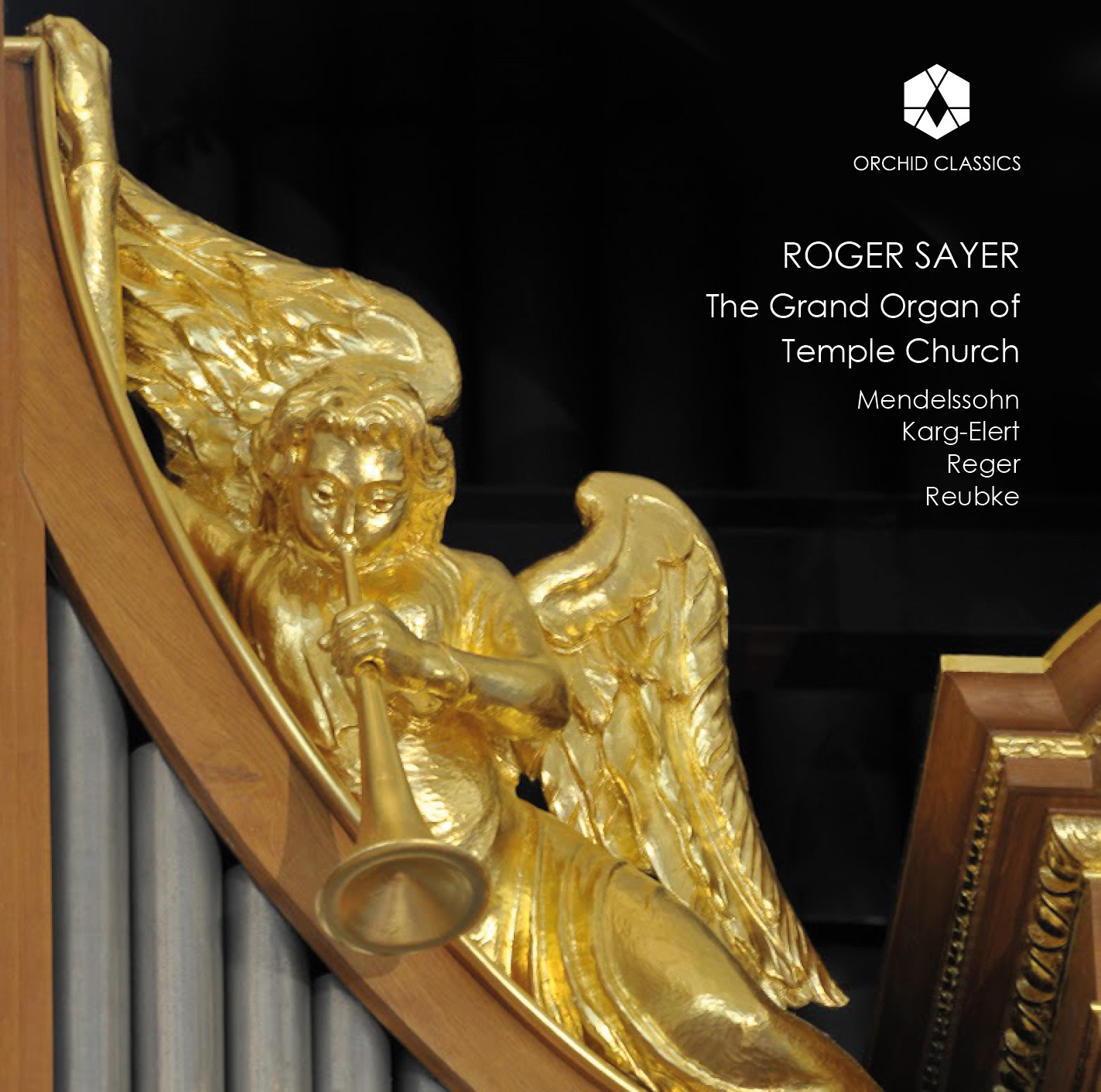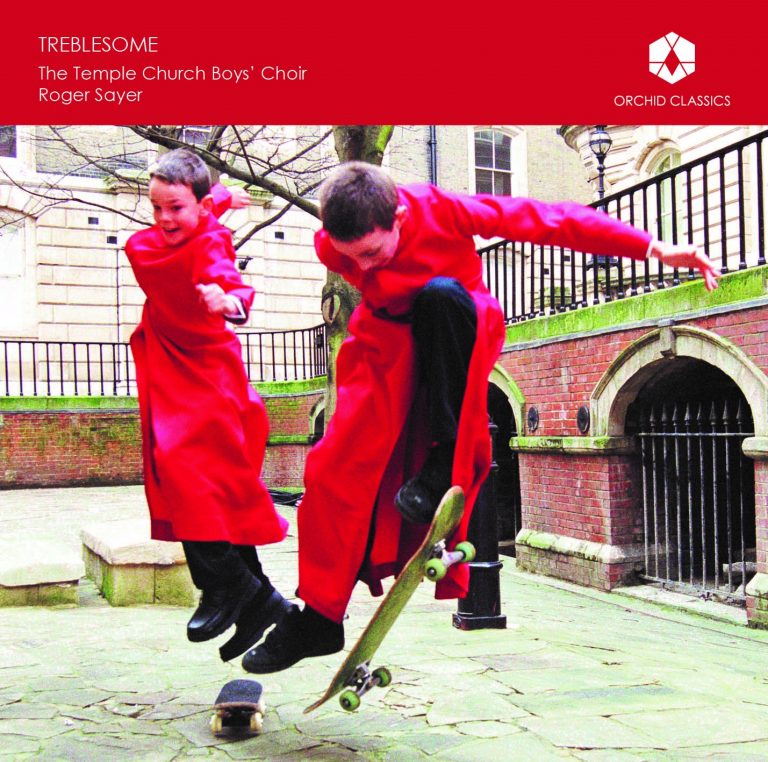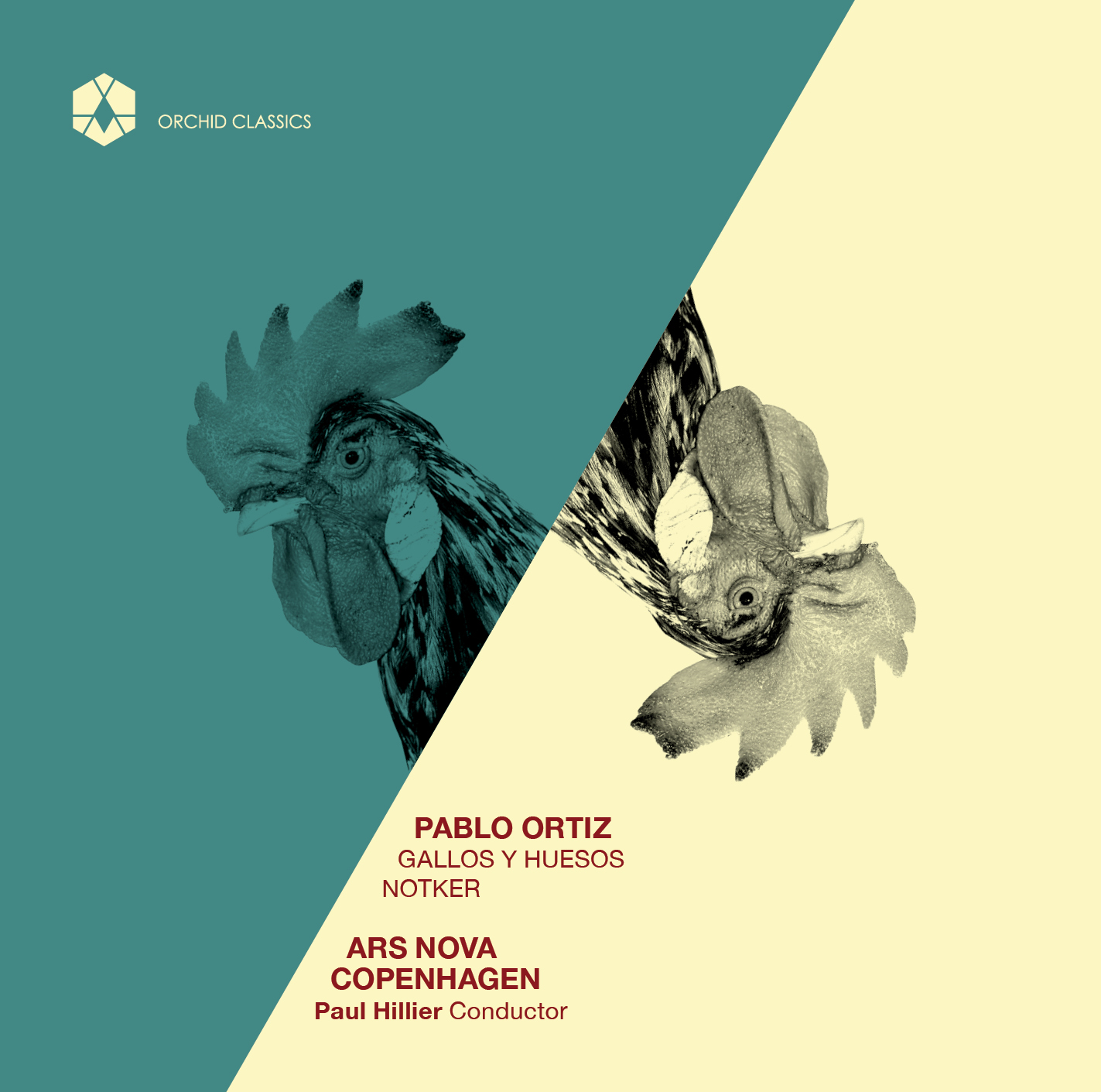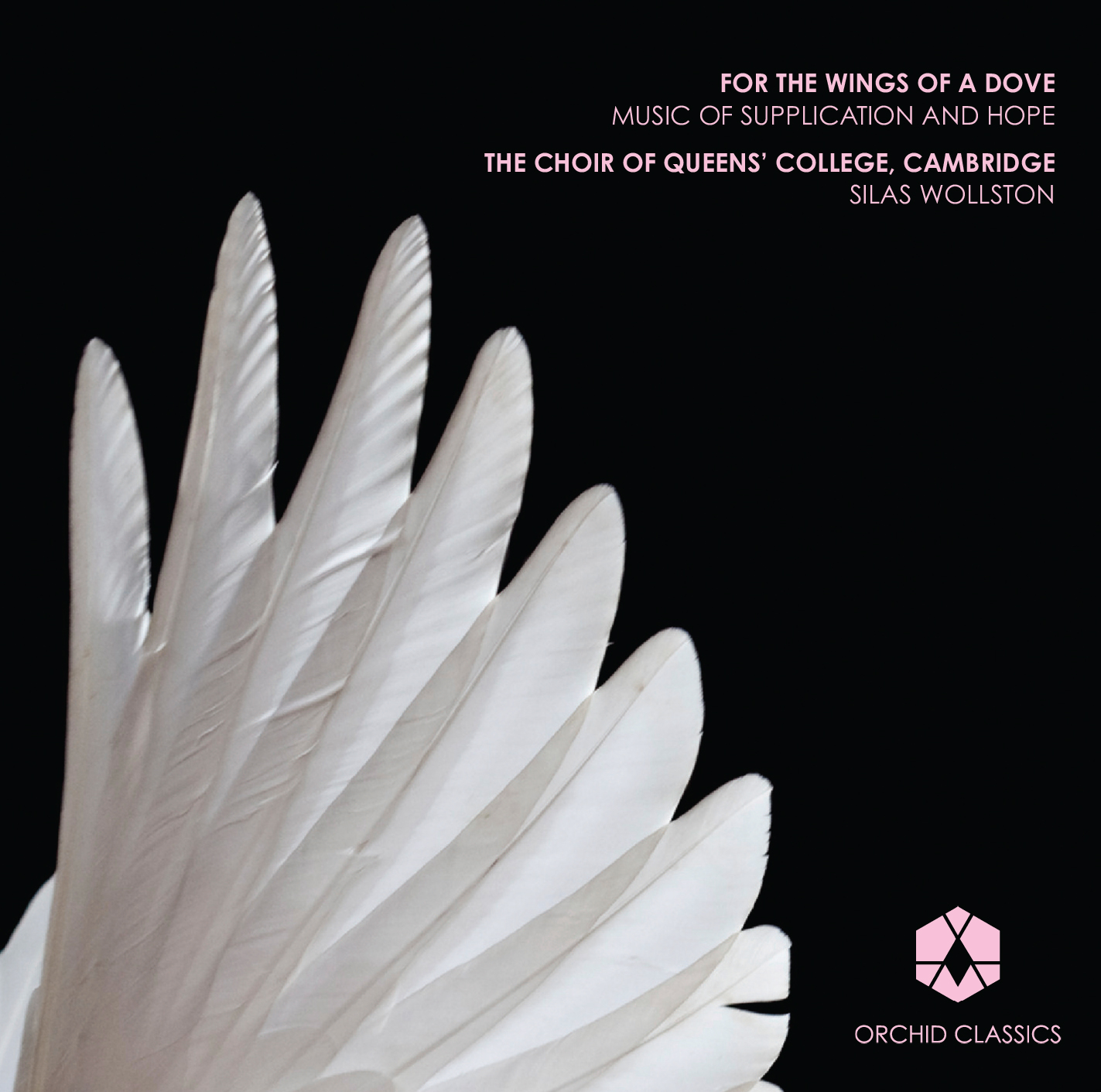Artist Led, Creatively Driven

The Grand Organ of Temple Church
Roger Sayer, organ
Release Date: 16th November 2018
ORC100090
THE GRAND ORGAN OF TEMPLE CHURCH
Felix Mendelssohn (1809–1847)
Organ Sonata No.1 in F minor, Op.65 No.1
1 I Allegro e serioso 5.22
2 II Adagio 3.18
3 III Andante recitativo 3.28
4 IV Allegro assai vivace 3.15
Sigfrid Karg-Elert (1877–1933)
Symphonic Chorale Jesu, meine Freude, Op.87 No.2
5 I Introduzione (Inferno) 6.01
6 II Canzone 5.43
7 III Fuga con Chorale 8.07
Max Reger (1873–1916)
8 Chorale Fantasia: Hallelujah! Gott zu loben 13.35
Julius Reubke (1834–1858)
Sonata in C minor on the 94th Psalm
9 I Grave – Larghetto – Allegro con fuoco – Grave 12.03
10 II Adagio – Lento 6.11
11 III Allegro – Più mosso – Allegro assai 7.06
Total time 74.15
Felix Mendelssohn (1809–1847)
Organ Sonata No.1 in F minor Op.65 No.1
On 11 March 1829, at the Singakademie in Berlin, Felix Mendelssohn conducted the first complete performance of Bach’s St Matthew Passion to have been given since the death of its composer in 1750. Mendelssohn had grown up hearing and playing Bach’s keyboard music at home and in later years, whenever the opportunity arose, he would do all he could to make Bach’s music known even when audiences were apathetic, or worse.
In a letter written on 17 October 1777, Wolfgang Amadeus Mozart had referred to the organ as the ‘King of Instruments’, but by the mid-1830s, Liszt was complaining that ‘the holy father of instruments’ was being abused ‘with vaudeville songs and gallops!’. To some extent, therefore, it fell to Mendelssohn to do for organ music what he had done for Bach, and to bring it back into the world of serious music.
Before long, inspired by Bach’s example, he was composing organ pieces of his own. In 1833 he composed a fugue which, together with two others and three preludes, was to form part of his Three Preludes and Fugues which were published in 1839 as his opus 37. In the mid-1840s, the London publishing firm of Coventry and Hollier issued four volumes of Bach’s organ works edited by Mendelssohn and shortly afterwards brought out what was announced as ‘Mendelssohn’s School of Organ Playing’. This consisted of the six organ sonatas, which now bear the opus number 65. Originally described as ‘voluntaries’, Mendelssohn had created them from various pieces he had already composed. Together with several Lutheran chorales he collected them together in the manner of Bach’s suites rather than in classical sonata form.
Sigfrid Karg-Elert (1877–1933)
Symphonic Chorale Jesu meine Freude Op.87 No.2
Born in Oberndorf am Neckar on 21 November 1877, Sigfrid Karg-Elert was the youngest of twelve children of Jean-Baptiste Karg, who was a newspaper editor and publisher. (It was later, when his music was to be published for the first time, that he added a variant of his mother’s maiden name to that of his father and also changed the spelling of his first name from Siegfried to Sigfrid.) Having moved with his family to Leipzig when he was five, he began his musical education in that city as a member of the Johanniskirche choir. There he was encouraged by the Cantor who was, before long, conducting performances of choral works which the young lad had composed. The death of his father in 1889 left the family in straitened circumstances and it was decided that Sigfrid should train to become a teacher. In 1896, however, he was awarded a scholarship to study at the Leipzig Conservatory and, in order to support himself financially, he became an orchestral musician and, wearing a wig and a fake beard to avoid recognition, played the piano in cafés.
For a while, Karg-Elert, devoted a considerable amount of his time, both as composer and performer, to the harmonium. Indeed, during the mid-1920s, he could be heard each week on the radio giving a recital on that instrument from his own home. Later he was to transcribe for the organ some of his compositions for the harmonium and also to add many original works to its repertoire. (He also wrote extensively for the piano and famously made piano arrangements of Elgar’s two symphonies). It was in 1913 that he produced his three Symphonic Chorales, of which the second is based on the chorale Jesu meine Freude by Johann Cruger (1598-1662) and the notes BACH (that is, B flat, A, C and B natural). Karg-Elert dedicated this piece to Karl Straube (1873-1950) who was at that time organist at St Thomas’s School in Leipzig for which Bach had composed his motet Jesu meine Freude when he was Cantor there.
Max Reger (1873–1916)
Chorale Fantasia: Hallelujah! Gott zu loben
During his comparatively short life, Max Reger composed a great deal of music; some would say far too much. Eric Blom, writing in Grove’s Dictionary of Music and Musicians, goes so far as to say that he ‘unquestionably wrote too much music’ and that almost every piece ‘is stuffed far too full of notes and especially of accidentals’. He does allow, however, that Reger ‘was in a sense a great as well as a too abundantly creative musician’. (In a subsequent edition of Grove, Helmut Wirth describes Reger as ‘the most important German organ composer after Bach’.)
Having taught at the Munich Academy of Music during the early years of the twentieth century, in 1907 Reger moved with his wife Elsa and two adopted daughters, Christa and Lotti, to Leipzig where he became Director of Music at the University and Professor of Composition at the Conservatoire, a post he was to retain for the rest of his life.
Composed in September 1900, the Fantasia on ‘Hallelujah! Gott zu loben, bleibe meine Seelenfreud!’ (Alleluia! May the praise of God remain my soul’s joy!), is the third of three chorale fantasias which bear the opus number 52, the others being Alle Menschen müssen sterben and Wachet auf, ruft uns die Stimme. Reger dedicated the second of these fantasias to Karl Straube who gave the first performances of all three during 1901, the third having its premiere in Munich on 9 November. Reger and Straube, who were exact contemporaries, had been friends for many years and Reger’s admiration for Straube’s playing had caused him to compose some of his finest works. There was, however, a friendly warfare being waged between them with Reger trying to write works which would defeat even Straube’s virtuosity, but he always failed.
Julius Reubke (1834–1858)
Sonata in C minor on the 94th Psalm
Unfortunately, Julius Reubke did not live long enough to add to the repertoire of the organ much more than his Sonata on the 94th Psalm, but this one piece has ensured that his name will not be forgotten by organists for many years to come. It was in 1856 that Reubke went to study with Franz Liszt in Weimar, soon becoming one of his favourite pupils. The Sonata for organ, together with another in B flat minor for piano, was composed the following year, the organ sonata being given its first performance by the composer on the new Ladegast organ in Merseburg Cathedral on 17 June 1857.
Reubke was born in March 1834 at Hausneindorf, his father, Adolf, like Friedrich Ladegast, being a well-known German organ builder. He studied first with Hermann Bönicke in nearby Quedlinburg and then, in 1851, enrolled at the Berliner Musikschule which had opened the previous year. There he studied with two of its co-founders, Theodor Kullak for piano and Adolf Bernhard Marx for composition, won the most prestigious prizes and, later, taught the piano for a while. At the end of 1857 he moved to Dresden where he acted as pianist for the Dresdner Tonkünstlerverein until failing health – he was suffering from consumption – caused him to retire. He died on 3 June 1858 at the age of only twenty-four.
It is said that the inspiration to compose the Sonata on the 94th Psalm came, in part at least, from Liszt’s Ad nos ad salutarem undam, a half-hour-long fantasia and fugue for organ which was based on a chorale from Meyerbeer’s opera, Le Prophète. Reubke’s Sonata, although set out as one continuous movement, consists essentially of three sections each of which is based on the same theme. It is dedicated to Professor Carl Riedel who was another of Reubke’s teachers.
Roger Sayer
Roger Sayer is at the forefront of British choral and organ music. A former organ student at St Paul’s Cathedral, Sayer was Prize Winner at the 1989 St Albans International Organ Competition and won all the organ prizes at the Royal College of Music. Since then, he has been in constant demand both as a recitalist and accompanist, and his playing takes him to many parts of the world. His recent and upcoming highlights include recitals in Italy, Germany, Holland and Denmark, a major tour of Australia, a live recital at Temple Church broadcast on BBC Radio 3, opening the 2018 Summer Organ Festival at Westminster Abbey and the release of two new recordings for Priory and Signum records.
Roger Sayer’s work as organist has also extended into the film world, with his most recent performance as organ soloist for Hans Zimmer’s Oscar nominated score for the motion picture Interstellar. Sayer later went on to perform the work live with composer Hans Zimmer in a special concert at London’s Royal Albert Hall, which was attended by the film’s director, cast and supporters, including Christopher Nolan, Jessica Chastain, Professor Brian Cox and Professor Stephen Hawking.
In addition, Roger Sayer is also an acclaimed Choral Director with some of the UK’s finest choirs. After founding the Rochester Cathedral Girls’ choir, Sayer joined Temple Church in 2013 as Musical Director and has since created an impressive portfolio of recordings, broadcasts and concerts. Under his direction, Temple Church Choir has broadcast over thirteen times on BBC Radio 3 and Classic FM and undertaken several international tours of the USA, Holland, Singapore, Australia and Germany. In the summer of 2017, Roger conducted the choir at the St Albans International Organ Festival ‘Three Choirs’ concert, alongside the choirs of St Paul’s Cathedral and St Albans Abbey. Sayer also recently initiated a new youth choir of Boys and Girls at Temple Church, which gave its debut in November 2017.
Outside of Temple Church, Roger Sayer works regularly with the London Symphony Chorus. In his capacity as Accompanist and Deputy Chorus Director, Sayer has collaborated with many of the world’s leading conductors and soloists.









